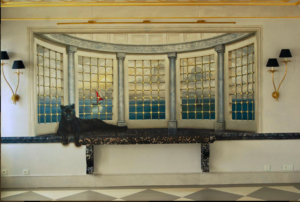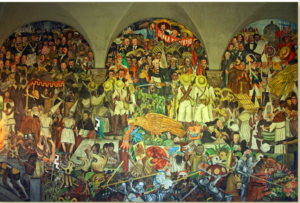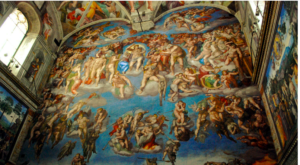19 Jul The tradition of Mural Paintings
Murals date back to 30,000 BC from the earliest paintings in the Chauvet caves in
France. A large number of ancient mural paintings are from Egyptian tombs in 3150 BC,
Pompeii in 100 BC-AD79 and Minoan places 1700-1600BC.
Over the course of time, murals have covered the interiors and exteriors of many public
and private buildings, including palaces, temples, tombs, museums, libraries, churches
and the houses of rich art patrons, in the latest evolution of mural painting spreading
onto the streets and architectural elements, all the while keeping their initial meaning
and purpose which is to paint a picture of society, created from stories, values, dreams,
change or for purely a decorative nature.

The word mural originates from the Latin word “murus”, meaning wall. Today, we can
define mural art as any piece of artwork painted or applied directly onto a wall, ceiling or
other larger permanent surfaces. Mural painters in Rome favoured painting on fresh
plaster called ‘frescos’ a difficult process leaving little room for error as the plaster dried
quickly sealing the paint pigments into the wall for eternity.

Renaissance artists such as Tiepolo, Leonardo Da Vinci and Michelangelo Buonarroti
created huge murals mostly depicting Holly scenes for churches and it was probably not
until the 1920’s that mural painting flourished on that scale.The masters of the
Renaissance painted with oil paints directly onto the prepared surfaces but another
technique became popular Marouflage which is a technique for fixing a painted canvas
(intended as a mural) to a wall, using an adhesive, this has the advantage of the
muralist being able to paint the mural in his atelier and transport it to the location.

It was during Mexican Muralism (the 1920’s)that murals got a new dimension as a
powerful visual communication tool, meant to promote the opinion of the people and to
transmit ‘social and political messages towards unity’. Through the large paintings of the
three greatest painters of the time, Diego Rivera, José Clemente Orozco and David
Alfaro Siqueiros, mural painting became the most important form of expression, often
the subject of controversy and always a symbol of solidarity, freedom and hope.
Mexican mural art inspired the creation of many other similar movements around the
world, the biggest being the Chicano art movement in the 1960s.Murals have also
represented one of the most important features of the Northern Ireland struggle,
depicting the region’s past and present political and religious divisions. Since the 1970s,
the country has seen almost 2,000 wall mural paintings dedicated to the fight against
racism and environmentalism, among many other issues. Another famous place
charged with political murals was the Berlin Wall, whose Western side saw many murals between
its creation in 1961 and its destruction in 1989, including the works by Keith
Haring and Thierry Noir.
Today murals have many places in our modern day society as purely decorative and
also staying true to their role of expressing religious and political beliefs within societies.
Murals can represent a mighty tool of emancipation, freedom of expression and social
activism and propaganda. Wall mural painting is considered as an important aspect of
socially engaging art and plays a significant role in the relationship between art and
politics.




No Comments